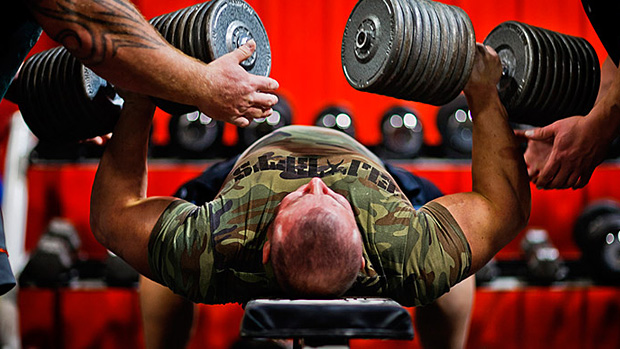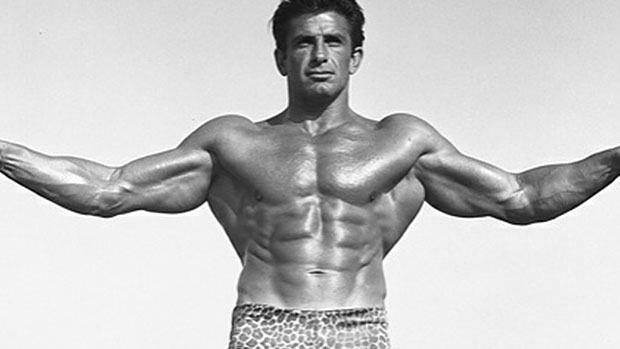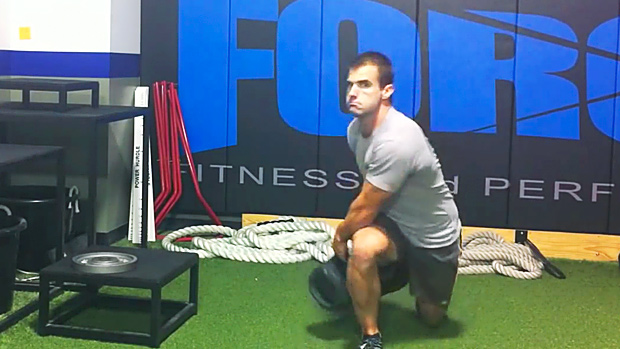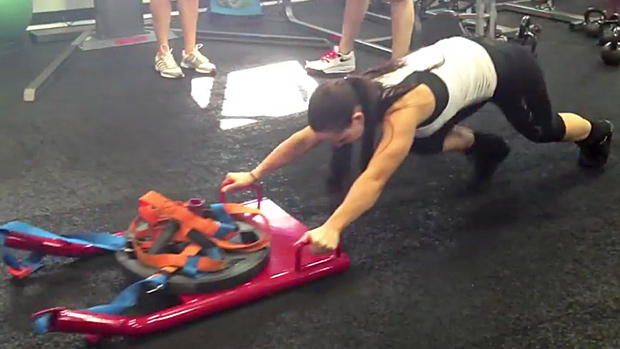The barbell bench press has its place, but dumbbell benching has several advantages over the bar. Bench pressing with dumbbells allows you to work stabilizer muscles that are ignored by benching with a bar. It also gives you a great opportunity to really work the pecs hard at the top of each and every rep with certain variations. Check out these tough options.
1. Continuous Tension Sets
Working your muscles through a full range of motion is almost always a good idea. It'll develop your muscles to their greatest potential and accelerate your gains. However, there are a couple of things you must consider.
It's important to keep tension on the working muscles and increase the time under tension for each and every set. One advanced method to achieve this is called continuous tension sets, which is a technique that defies the time-honored tradition of locking out every rep. Just stop right before the weights are locked out at the top and proceed directly into the next rep.
2. Continuous Tension with Slow Negatives
To further increase greater muscular tension and metabolic stress, use a slow negative, lowering the weight for a count of 3-5 seconds.
This method takes advantage of the continuous tension sets, keeping the muscle loaded and increasing the time under tension. You also get the benefit of exposing the muscle to eccentric training, which causes more muscle damage and leads to greater rates of protein synthesis post-workout.
3. Band-Resisted Bench Press
Use this one to bust through a strength plateau. Your triceps and chest will experience tremendous force as the tension on the band increases with every inch you drive the weights up.
4. Band-Resisted Bench Press, Bands Anchored
In the conventional dumbbell bench press, the pec major acts against the weight to adduct the humerus (brings it closer) to the midline. The load acts vertically across the system (intermuscular coordination) of the chest, triceps, and shoulders.
In this variation we add a force vector to the system that acts diagonally, driving the arms and dumbbells laterally away from the midline. As you can imagine, it'll force you to fight just to keep the dumbbells on their intended vertical path, which creates an insane muscular contraction, particularly when you push the dumbbells together at the peak of the movement.
5. One-Arm Dumbbell Bench Press
This is an exercise that will create superb full-body tension and it offers a lot in the way of core anti-rotation strength. Brace your lats, keep air in the abdomen, and press your feet into the floor. To avoid getting sloppy, keep the reps per set at 8 or under. Don't be fooled by how simple it looks. You'll need to keep massive full-body tension from the very first rep.
6. Slow Negatives
Studies have shown that your body can tolerate up to 1.75 times more weight eccentrically (lowering the weight) than it can concentrically (lifting up the weight). And if you emphasize the eccentric portion, then you're certain to increase muscle growth.
This isn't to suggest that you only do eccentric training, though. Just take advantage of your body's potential to handle more weight while still doing the full movement. Slow negatives allow more time under tension during the eccentric phase where we can handle more load. The great thing about this is it allows you to work out at a higher intensity, and higher intensity means greater stress, which means greater adaptation.
7. Isometric Holds
A very significant benefit of isometric training is that it produces a greater level of activation than any other type of contraction. One of the main benefits of isometric training is that the body is able to activate nearly all the available motor units, something that's usually very difficult to do.
Just push the dumbbell heads together and contract through the pecs. Another challenging element you can add to the isometric part is to have a partner add a small amount of pressure (just below the wrists) to pull the dumbbells apart. This helps fully contract and activate the pectorals.
8. Slow Negatives with Isometric Holds
Combining both slow eccentrics and isometric work on each rep creates a highly effective and challenging exercise as it grants the benefits from both types of training. This can be very taxing if done correctly, so try to get a partner to keep you honest on both elements of the exercise.
9. Drop Set With Fast Reps on the Last Set
When you do a straight set (8 to 12 reps with one weight), you don't hit all the muscle fibers, only the number of fibers required to lift a specific weight for a specific number of reps. But by adding a drop set and stripping off 10 to 20 percent of the weight and continuing the set, you begin to recruit reserve fibers. The primary focus of drop setting is to "shock the muscle" by adding stress to a standard set.
Do 8 controlled reps and then drop the weight by 15 percent for the second set of 8 controlled reps. Then you'll drop it another 15 percent for the third set, but you'll do this last set with fast reps rather than controlled reps.
This intentional change of speed ensures that you can do a greater number of reps on the third set. It'll also start to incorporate the fast-twitch muscle fibers to a greater degree – the fibers with the highest potential for growth.





